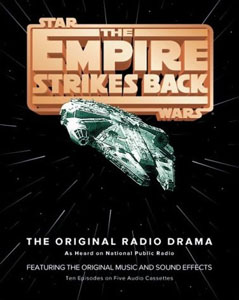“The Empire Strikes Back” radio drama (1983) is a notable step down from the “Star Wars” radio drama from two years prior. If you read between the lines, writer Brian Daley’s introduction to the 1995 publication of the script gives the reason why: “We decided on 10 episodes rather than 13, due to both time and budget constraints.”
The “Empire” radio drama is five hours long. That’s an hour-and-a-half shorter than the “Star Wars” radio drama, but still three hours beyond the length of a movie. However, “Empire” conveys more information visually than any other “Star Wars” film. By definition, radio plays can’t be visual, and the “Star Wars” plays use narrator Ken Hiller only at the beginning and end of each half-hour.
So every visual moment has to be conveyed through dialogue. As such, we get awkward lines like Luke saying “The Force calls my lightsaber — to me!” or Yoda saying “Ashore, it comes, because it will. And so: It is here” or Vader saying “Observe that control bar. The Force can tear it loose. The Force allows me to use it for any purpose I choose – even as a missile!”
By the time Daley has used dialogue to describe all of the beautifully wordless moments in “Empire,” most of the five hours is used up. Whereas “A New Hope” has entire chapters devoted to new sequences – in fact, the film’s action doesn’t start until the third episode – “Empire” does not. Parts of some episodes provide new material, though, most notably:
- In the sequence that opens the radio play, a rebel convoy led by Commander Narra is completely wiped out. This serves to illustrate that it’s a dark time for the Rebellion. Wedge later notes that he respected Narra, who would go on to appear in the ” ‘General’ Skywalker” arc of the “Empire” comic series.
- Luke and Han talk in the survival shelter. It mostly consists of jokes like wanting to send out for room service. Daley misses an opportunity for insight into Luke’s feelings about his Jedi path or Han’s feelings about the Rebellion and Leia.
- We see a bit of the “dinner” scene (they don’t literally eat a meal) after the dramatic moment when Vader and Fett are revealed behind the door. It consists of Han acting brash and Vader taunting him.
- Luke mumbles “Ben told me Vader had killed my father.” Leia doesn’t pick up on it, thus allowing her to be surprised when Luke finally reveals her heritage in “Return of the Jedi,” which hit theaters a couple months after the “Empire” radio drama aired.
So what could have been added if Daley had three more episodes to work with? Perhaps he could’ve told the tale of the Rebels discovering the Hoth cave and setting up their base. This would’ve required coordination with the Goodwin/Williamson comic strip arc “Iceworld” (1982), which was being written roughly simultaneously with Daley’s script. A lack of in-universe synergy was a problem on the “A New Hope” radio play (see the replacement of Jabba with Heater and the renaming of Bail Organa as Prestor), so if Daley had delved deeper, he almost certainly would have created contradictions.

In fact, Daley also wrote the script for the vinyl record drama “Rebel Mission to Ord Mantell” (1983), and that contradicted Goodwin’s comic strip “The Bounty Hunter of Ord Mantell” (1981) (although technically both stories can exist in the EU timeline). Since Daley knew he only had 10 episodes to work with, we’ll never know what he might’ve done with 13, but perhaps a version of “Rebel Mission to Ord Mantell” would’ve been the lead-off episode.
With more episodes, perhaps Daley could have worked with the odd flow of time in the middle chunk of the movie, where it seems like Luke is training for a long time while Han and Leia are fairly quickly moving from the Hoth asteroid belt to Bespin. Maybe an additional adventure with the Falcon could’ve been inserted there, allowing the Dagobah scenes more room to breathe. Maybe Daley could’ve added another training lesson, too, something along the lines of the comic book “Luke Skywalker and the Treasure of the Dragonsnakes.”
All of this having been said, die-hard fans will still enjoy “Empire” because of the performances of Mark Hamill, Anthony Daniels and Billy Dee Williams, reprising their movie roles, and Ann Sachs (Leia), Perry King (Han) and Bernard Behrens (Ben) reprising their “Star Wars” radio drama roles.
Brock Peters’ Darth Vader continues to be a jarring take on the role, with a lot of anger seeping into his voice where James Earl Jones played things more coolly. John Lithgow’s Yoda is not too bad (his voice is too deep, but the inflections are correct), but he’s not in the same league as Tom Kane from “The Clone Wars.” Paul Hecht’s Emperor is in the ballpark. Don Scardino’s Wedge sounds too much like a little kid, but at least it’s better than the ethnic Wedge from the “A New Hope” radio drama.
Tom Voegeli is the hero of the piece, as he splices in music and sound effects (including the performances of Artoo and Chewie). He keeps the radio play feeling like “Star Wars” even when the talkiness undermines the spiritual nature of Irvin Kershner’s movie. Either Voegeli or Daley (who was on-set during the recording sessions) are responsible for some nice saves, too. For example, the script has Han say “I know that, Leia. And I love you!” But in either the recording session or the editing room, it’s shortened back to the iconic “I know.” (Die-hard fans will want to pick up the 1995 script book to follow the numerous alterations that were made during recording.)
Overall, though, “Empire” is a letdown. “A New Hope” gave us whole new chapters and made the saga feel bigger. The sequel uses most of its energy adapting a great visual film into a clunky radio drama, and the sparse extra material feels too much like padding.

